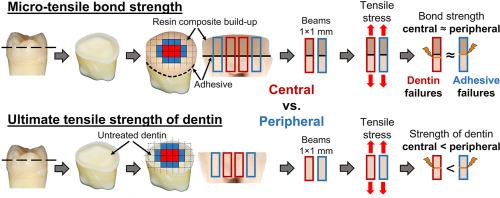Journal of the Mechanical Behavior of Biomedical Materials ( IF 3.9 ) Pub Date : 2020-12-26 , DOI: 10.1016/j.jmbbm.2020.104295 Antonin Tichy , Marek Brabec , Pavel Bradna , Keiichi Hosaka , Ayaka Chiba , Junji Tagami

|
The bonding performance of dental adhesives is most frequently evaluated using the micro-tensile bond strength (μTBS) test. Despite lacking evidence, peripheral specimens are often discarded to avoid regional variability. This study, therefore, examined whether μTBS to central and peripheral dentin differed. Dentin surfaces of extracted human molars were bonded with various self-etch adhesives, built up with a resin composite, cut into beams, and stressed in tension. Failure mode was classified as adhesive, cohesive in dentin, or other using scanning electron microscopy. Since cohesive failures in dentin were frequent and could confound μTBS results, the data from central/peripheral dentin were analyzed using a Weibull competing risk (CR) model distinguishing failure modes, and its outcomes were compared to a conventional failure mode non-distinguishing Weibull model. Based on the strength data of cohesively failed specimens, the CR model also estimated the strength of dentin. For comparison, the ultimate tensile strength (UTS) of dentin was measured in both regions. The conventional model suggested that peripheral μTBS was higher than central μTBS. Conversely, the CR model disclosed no significant difference in μTBS between the regions but indicated a higher strength of peripheral dentin. This finding was confirmed by UTS measurements, and further supported by the significantly higher incidence of cohesive failures in central dentin. Therefore, peripheral specimens can be used in the μTBS test as well as central ones, but a CR model should be used for statistical analysis if cohesive failures in dentin are frequent, as the strength of peripheral dentin is higher.
中文翻译:

使用竞争风险模型估算中央和周围牙本质对微拉伸粘合强度的影响
牙科粘合剂的粘合性能最经常使用微拉伸粘合强度(μTBS)测试进行评估。尽管缺乏证据,但经常丢弃外围标本,以避免区域差异。因此,本研究检查了中央和周围牙本质的μTBS是否存在差异。提取的人类臼齿的牙本质表面用各种自蚀刻胶粘剂粘合,用树脂复合材料制成,切成横梁,并施加压力。使用扫描电子显微镜将失效模式分类为粘合,牙本质粘合或其他。由于牙本质的内聚性衰竭频繁发生,并且可能使μTBS结果混淆,因此,使用区分失败模式的Weibull竞争风险(CR)模型分析了中央/周围牙本质的数据,并将其结果与传统的失效模式无区别威布尔模型进行比较。根据内聚失败样本的强度数据,CR模型还可以估算牙本质的强度。为了比较,在两个区域中都测量了牙本质的极限拉伸强度(UTS)。传统模型表明,外围μTBS高于中央μTBS。相反,CR模型显示区域之间的μTBS没有显着差异,但表明外周牙本质强度更高。UTS测量结果证实了这一发现,并且中央牙本质的内聚力破坏发生率明显更高,进一步证明了这一发现。因此,外围样品可以用于μTBS测试,也可以用于中心样品,但是如果牙本质的内聚破坏频繁发生,则应使用CR模型进行统计分析,



























 京公网安备 11010802027423号
京公网安备 11010802027423号